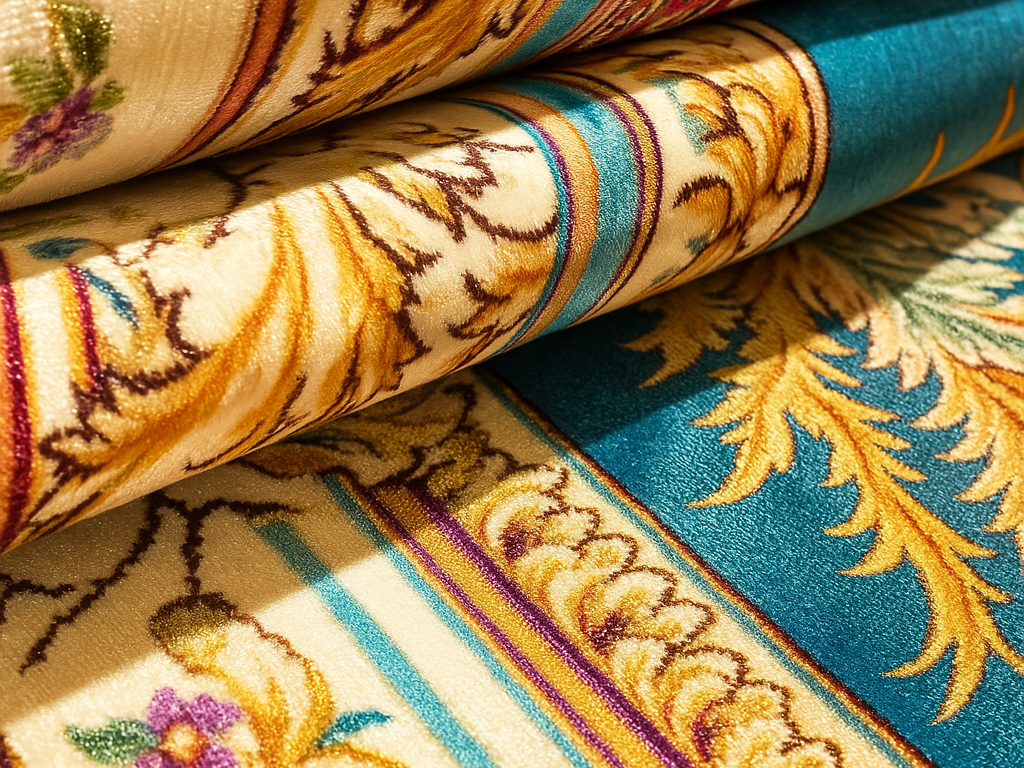식탁에 딱 맞는 러그 크기를 선택하는 것은 단순한 디자인 결정이 아니라 조화롭고 기능적인 공간을 만드는 일입니다. 잘 선택한 러그는 식사 공간의 미적 매력을 향상시킬 뿐만 아니라 식사 중 편안함과 실용성을 보장합니다. 하지만 크기, 가구 배치, 공간 비율의 균형을 고려해야 하므로 적절한 크기를 선택하는 것은 쉽지 않습니다.
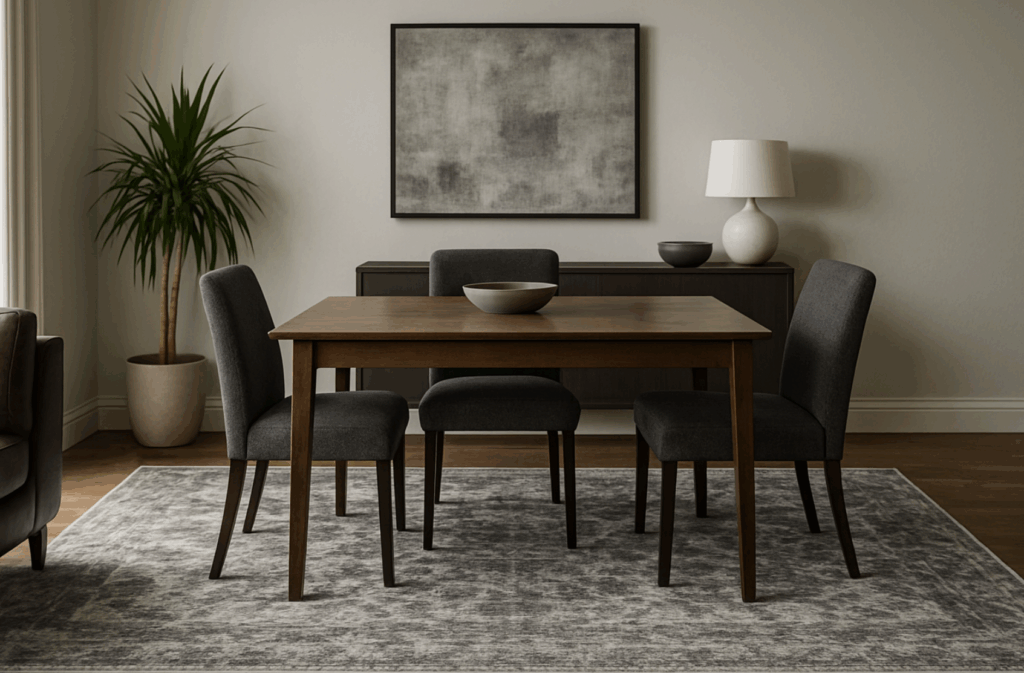
이 종합 가이드에서는 식탁 모양, 의자 간격, 공간 배치 등의 요소를 고려하여 식탁에 적합한 러그 크기를 결정하는 방법을 살펴보세요. 아늑한 구석을 꾸미든 넓은 식당을 꾸미든, 전문가 팁을 통해 자신의 스타일을 보완하고 기능적 요구 사항을 충족하는 정보에 입각한 선택을 할 수 있습니다.
1. 다이닝룸 러그 크기를 맞추는 방법
적절한 러그 크기를 선택하려면 단순히 마음에 드는 디자인을 고르는 것만으로는 부족합니다. 식탁의 크기, 의자 수, 방의 레이아웃을 고려하는 것이 중요합니다. 다음은 단계별 접근 방식입니다:
- 식탁 측정: 식탁의 길이와 너비를 측정하는 것으로 시작하세요.
- 추가 공간 추가: 의자가 깔개를 넘어뜨리지 않고 편안하게 꺼낼 수 있도록 테이블의 양쪽 치수에 24~36인치를 추가하세요.
- 방 레이아웃 고려하기: 러그가 방의 크기에 맞는지 확인하고 가능하면 러그 가장자리와 벽 사이에 최소 12인치의 간격을 두세요.
- 테이블 확장 계정: 테이블에 잎사귀나 연장 테이블이 있는 경우, 더 많은 인원이 모일 수 있도록 치수에 포함하세요.
관련 읽기: 다이닝룸 러그: 선택, 스타일링 및 관리에 대한 종합 가이드
2. 다이닝 룸 러그의 표준 크기
식탁 아래를 세련되고 기능적으로 보이게 하려면 일반적인 러그 크기로 시작하는 것이 현명하지만, 그 이유를 이해하면 더욱 좋습니다.

일반적인 표준 크기
- 8 × 10 피트 및 9 × 12 피트 이 사이즈는 가장 자주 권장되며 특히 6~8명이 앉을 수 있는 테이블에 적합한 다양한 식사 설정에 적합합니다. 의자를 놓을 공간이 넉넉하고 레이아웃의 균형을 유지하는 데 도움이 됩니다.
- 더 작은 옵션: 5 × 7 피트 및 6 × 9 피트 보다 컴팩트한 공간이나 작은 테이블(예: 4인용)에 이상적입니다. 이 크기는 의자가 움직일 수 있는 충분한 표면적을 제공하면서 공간을 개방적으로 유지합니다.
- 원형 및 정사각형 러그 원형 식탁의 경우 지름이 8피트 또는 10피트인 원형 러그가 시각적 조화를 이루며, 정사각형 러그는 정사각형 테이블과도 잘 어울립니다.
테이블 크기와 러그 크기 맞추기
- 경험 법칙: 48 추가 인치 (4피트) 다음에서 제공하는 가이드라인을 참고하세요. 더 스프루스 는 의자가 깔개에서 떨어지지 않고 자유롭게 움직일 수 있도록 테이블의 양쪽에 48인치를 추가할 것을 권장합니다.
- 예를 들어
- 4′×6′ 테이블은 일반적으로 8′×10′ 러그를 사용합니다.
- 6′×10′ 테이블은 10′×14′ 러그와 잘 어울립니다.
- 평균 객실과 러그 크기 비교 평균 14′×16′(약 4.3×4.9m) 크기의 식당에서는 9′×12′ 러그가 가장 적합하며, 공간을 압도하지 않으면서도 식당을 감싸기에 충분한 크기인 경우가 많습니다.
크기가 중요한 이유
- 의자 클리어런스 마모 방지 최소한 24 인치 의 러그를 테이블 가장자리 너머에 두면 의자를 잡아당겨도 지지력을 유지하여 마모와 걸려 넘어질 위험을 줄일 수 있습니다.
- 시각적 균형과 리듬 러그는 테이블을 시각적으로 고정할 수 있을 만큼 충분히 크되, 균형을 위해 가장자리(벽에서 12인치 정도 떨어져 있는 것이 이상적)에 공간을 남겨야 합니다.
- 공간 정의 개방형 공간에서 러그는 식사를 위한 명확한 '구역'을 만드는 동시에 공간의 일관된 흐름에 기여합니다.
관련 읽기: 적합한 러그 크기를 선택하는 방법: 방별 가이드
3. 다이닝룸 러그 사이즈 선택 방법
올바른 러그 사이즈를 찾는 것은 시각적인 조화만큼이나 스마트한 측정이 중요합니다. 러그의 기능성과 감각이 조화를 이루도록 하는 방법은 다음과 같습니다:
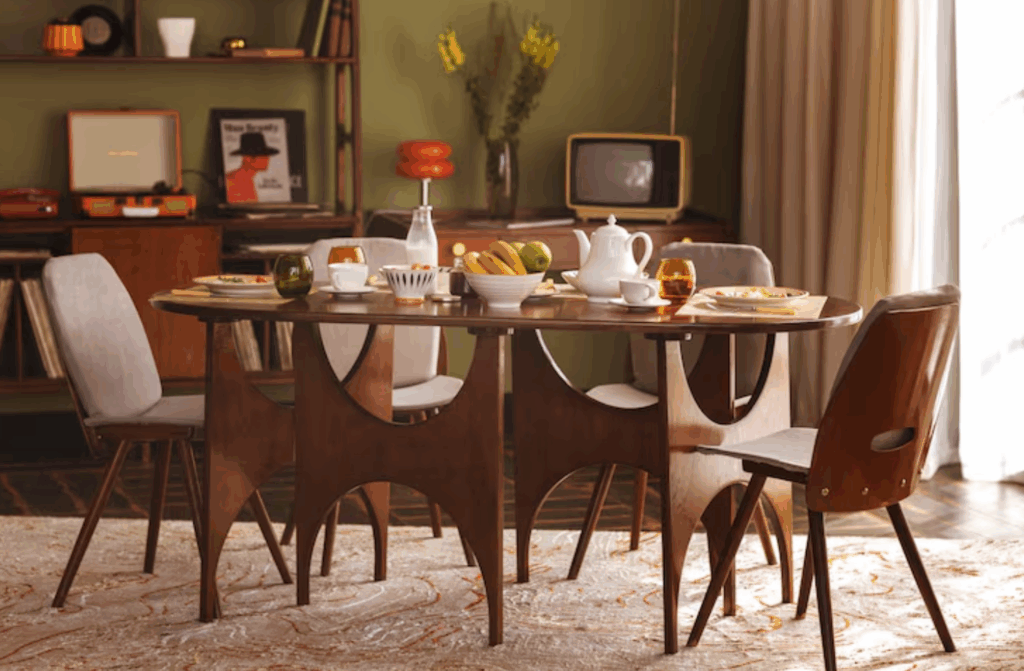
신뢰할 수 있는 경험 법칙 적용
- 24개 이상 추가 인치 를 식탁의 사방에 둘러 의자를 빼낼 때 러그에 단단히 고정되도록 하면 의자가 기울어지거나 걸리는 것을 방지할 수 있습니다.
- 건축 다이제스트 디자이너 까지 러그를 연장하는 것이 좋습니다. 3피트(36 인치) 테이블 너머로 균형 잡힌 외관과 향상된 편안함을 제공합니다.
모양과 흐름 일치
- 테이블의 모양을 미러링합니다. 정사각형이면 정사각형, 원형이면 원형, 직사각형이면 직사각형 등 러그와 함께 시각적 조화를 이루세요.
- 여전히, 창의적인 페어링 직사각형 러그 위에 둥근 테이블을 놓아두면 경쾌한 대비를 줄 수 있으며, 특히 절충주의 또는 레이어드 장식 스타일에서 매력적입니다.
공간 비율 존중
- Leave 12~24 인치 러그 가장자리와 벽 사이를 사용하여 더 나은 공간 균형과 구도를 위한 '숨 쉴 공간'을 확보할 수 있습니다.
- 표준 다이닝룸(약 14×16피트)이 있는 경우, 먼저 9×12피트 러그 를 사용하여 방이 잘게 잘리거나 스케일이 맞지 않는 느낌을 피할 수 있습니다.
구매 전 시각화하기
- 페인트용 테이프 또는 끈 사용 를 사용하여 바닥에 원하는 러그 크기의 윤곽을 그립니다. 이 방법은 비율을 시각화하고 지나치게 작은 러그와 같은 일반적인 실수를 방지하는 데 도움이 됩니다.
- 너무 작게 만들지 마세요.-의자가 놓이지 않는 러그는 방을 단절되고 좁아 보이게 만들 수 있습니다.
관련 읽기: 러그도 가구로 간주되나요? 완벽한 인테리어 디자인 분석
4. 식탁에 따라 러그 사이즈 선택하기
식탁의 모양, 크기, 사용 방식이 모든 것을 결정하는 식탁 러그 선택은 식탁 자체에서 시작됩니다. 정확하고 스타일리시하게 매치하는 방법을 소개합니다.
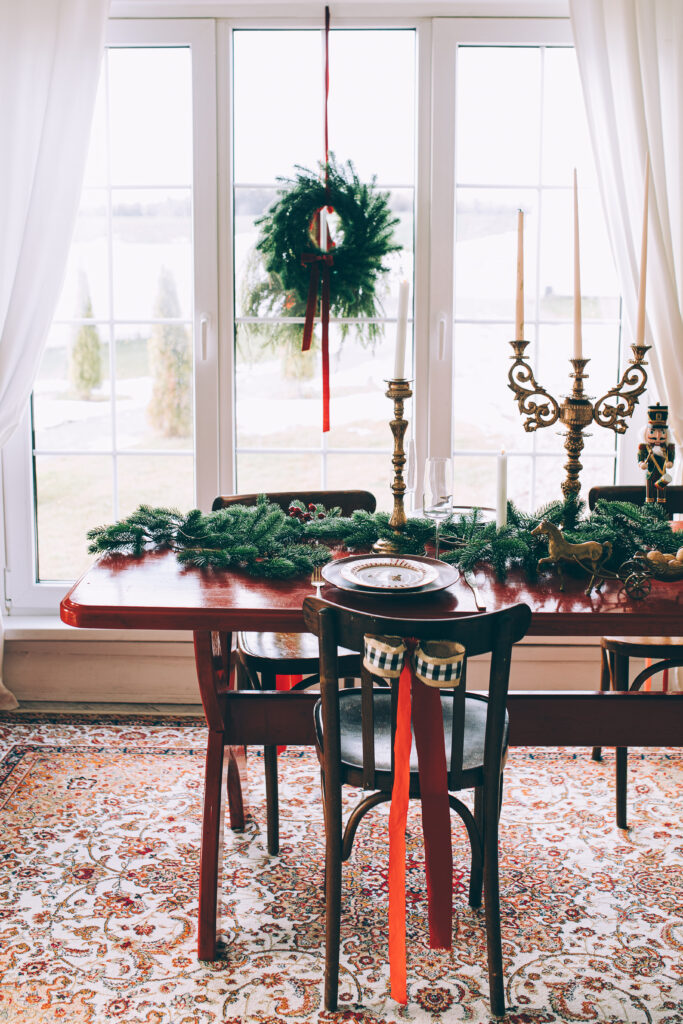
올바른 경험 법칙으로 시작하기
디자인 당국은 지속적으로 러그를 확장할 것을 권장합니다. 모든 가장자리에서 최소 24인치 이상 을 추가하세요. 이 완충재는 다리가 러그의 가장자리에 걸리지 않고 의자를 편안하게 빼낼 수 있도록 해줍니다. 러기블은 미터법으로 이 규칙을 반영하여 최소 60cm(약 24인치) 길이를 제안합니다.
표 모양: 일치 또는 대비?
- 직사각형 테이블: 직사각형 러그와 함께 사용하면 길이와 너비를 각각 4피트(약 48인치)씩 늘려 최적의 공간을 확보할 수 있습니다.
- 원형 또는 정사각형 테이블: 원형 러그가 가장 간단하며 동일한 연장 규칙을 유지합니다. 예를 들어 48인치 원형 테이블에는 최소 8피트 원형 러그가 필요하고 60인치 테이블에는 9피트 원형 러그가 잘 어울립니다.
- 색다른 분위기를 연출하고 싶으신가요? 예를 들어 정사각형 또는 직사각형 러그 위에 원형 테이블을 놓는 등 대조적인 모양을 조합하여 (동일한 크기 가이드라인을 유지하면서) 절충적인 레이어드 룩을 연출해 보세요.
테이블 확장(잎) 계정
모임 중에 나뭇잎으로 인해 테이블이 넓어지는 경우, 러그의 크기를 결정하는 것이 좋습니다. 확장된 차원-잎을 가끔씩만 사용하는 경우가 아니라면요. 이러한 경우에는 일상적인 테이블 크기를 기준으로 선택하면 충분할 수 있습니다.
이 템플릿 접근 방식 사용
- 테이블의 길이와 너비 또는 직경을 측정합니다.
- 총 48인치(4피트) 추가-즉, 한 면당 24인치입니다.
- 객실 크기 확인 를 사용하여 러그가 공간을 압도하지 않고 벽에서 최소 12인치 이상 떨어질 수 있도록 합니다.
- 테이프로 시각화하기 커밋하기 전: 바닥에 러그 영역을 윤곽을 그려서 간격이 비례적으로 느껴지는지 확인하세요.
관련 읽기: 러그에 묻은 커피 얼룩을 청소하는 방법: 전문가 가이드
5. 식탁 아래에 가장 적합한 러그 사이즈는 무엇인가요?
식탁 아래에 딱 맞는 러그 크기를 선택한다는 것은 스타일, 편안함, 실용성 사이의 균형을 맞추는 것을 의미합니다. 올바른 러그를 고르는 방법은 다음과 같습니다.
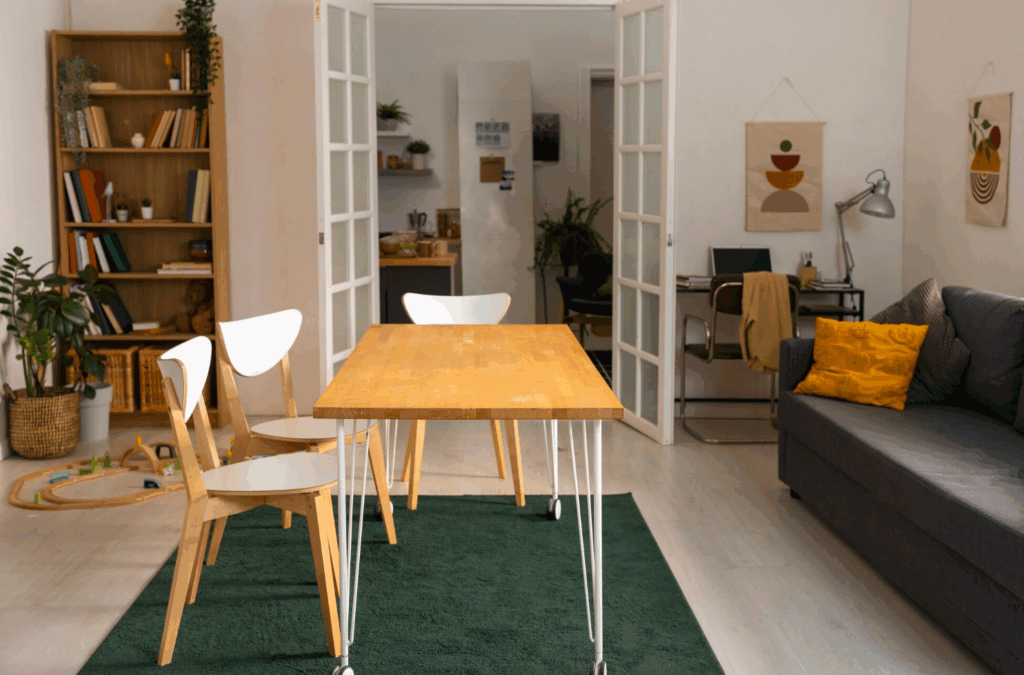
황금 크기 조정 규칙
신뢰할 수 있는 경험 법칙부터 시작하세요: 러그는 다음과 같아야 합니다. 최소 24인치(2피트) 연장 식탁의 모든 모서리를 감싸고 있습니다. 이렇게 하면 의자를 완전히 빼도 다리가 모두 러그에 남아 있어 걸림, 걸려 넘어질 위험, 고르지 않은 마모를 방지할 수 있습니다.
테이블 크기에서 러그 크기까지: 빠른 참조
전문가가 추천하는 페어링을 통해 더 쉽게 선택할 수 있습니다:
- 4인용 테이블(지름 약 48인치 원형 또는 3'×4′): 러그-8' 원형 또는 ~8'×8' 정사각형
- 6인용 테이블(예: 5'×8′): 러그-8'×10′
- 8인용 테이블(예: 6'×10'): 러그-9'×12′
다음을 추가하는 것이 좋습니다. 36인치 (3피트) 더 넉넉한 버퍼를 원한다면 양쪽 치수를 모두 늘려 고급스럽고 넓은 느낌을 연출할 수 있습니다.
시각적 조화를 위해 도형과 테이블 일치
- 직사각형 테이블: 직사각형 러그
- 라운드 테이블: 원형 러그(지름 24인치로 동일하게 추가)
- 정사각형 테이블: 스타일링 취향에 따라 정사각형 또는 원형 러그 선택 가능
하지만 사각형 러그 위에 원형 테이블을 배치하는 등 대담한 조합은 신중하게 크기를 조절하면 절충적이고 예술적인 분위기를 연출할 수 있습니다.
객실 크기와 레이아웃도 중요
- Leave 12-18인치 의 바닥을 깔개 가장자리와 벽 사이에 두어 균형과 숨 쉴 공간을 확보합니다.
- 개방형 공간에서는 더 큰 러그를 선택하세요. 10'×14' 이상-식사 공간을 시각적으로 정의하는 데 도움이 됩니다.
- 러그가 인접한 캐비닛 아래로 확장되거나 벽을 감싸는 경우 크기가 지나치게 커지면 부담스러워 보일 수 있습니다.
"클수록 좋다"는 생각은 여전히 한계가 있습니다.
약간 큰 러그가 너무 작은 러그보다 낫지만(의자가 미끄러지는 것을 방지하기 때문에), 지나치게 크면 불균형이 느껴지고 방의 매력을 삼켜버릴 수 있습니다.
6. 식당을위한 최고의 러그 재료
올바른 소재를 선택하는 것은 올바른 크기를 찾는 것만큼이나 중요합니다. 러그는 스타일이나 편안함을 희생하지 않으면서도 흘림, 의자 움직임, 일상생활을 견뎌내야 합니다. 다음은 발학 고객에게 완벽한 매치를 안내하는 데 도움이 되는 분석 자료입니다.

고려해야 할 주요 요소
자료를 살펴보기 전에 이러한 우선순위를 염두에 두세요:
- 내구성: 일상적인 사용, 진공 청소기, 의자 이동에도 견딜 수 있나요?
- 청소의 용이성: 유출된 러그는 스팟 클리닝이 가능한가요, 아니면 세탁이 가능한가요?
- 모양: 소재가 다이닝룸에 적합한 질감, 패턴, 파일 등 원하는 스타일을 제공하나요?
다이닝 룸을 위한 최고의 러그 소재
Wool
- 라놀린 덕분에 자연적으로 탄력이 있고 얼룩에 강하며 발바닥이 부드럽습니다.
- 액체를 짧게 흡수하여 신속하게 청소할 수 있습니다.
- 식당에 이상적인 직조: 낮은 파일 또는 평직(예: 킬림, 두리)으로 엎질러진 물과 미끄러지는 의자를 더 잘 처리할 수 있습니다.
- 가격이 비싼 편이며 시간이 지남에 따라 전문적인 청소가 필요할 수 있습니다.
- 커뮤니티에서 인용하기:
"울은 수십 년 동안 지속됩니다... 투자를 원하신다면 울을 선택하세요."
폴리프로필렌(올레핀)
- 얼룩에 강하고 습기에 강하며 경제성이 뛰어납니다.
- 세탁기로 세탁하거나 호스로 청소할 수 있는 옵션이 많아 어린이나 반려동물이 있는 가정에 적합합니다.
- 플랫 위브 스타일은 천연 섬유를 모방하여 쉽게 청소할 수 있습니다.
- 일부 저품질 버전은 인위적으로 보이거나 질감이 부족할 수 있습니다.
- Reddit 인사이트:
"폴리프로필렌 플랫 직조 러그는 식당에 잘 어울립니다. 청소도 쉽고... 반려동물과 아이들에게도 최고의 제품입니다."
나일론 & 폴리에스테르
- 나일론: 내구성이 뛰어나고 복원력이 뛰어나며 세척이 용이합니다. 용액 염색 버전은 얼룩과 변색에 잘 견딥니다.
- 폴리에스테르: 저렴하고 부드러우며 얼룩이 잘 지워지지 않습니다. 캐주얼하고 중간 정도의 트래픽이 많은 식당에 적합합니다.
면
- 가볍고 세탁기로 세탁할 수 있으며 경제적인 가격으로 캐주얼한 공간이나 사계절 공간에 이상적입니다.
- 플랫위브 텍스처는 이물질이 쌓이는 것을 방지하는 데 도움이 됩니다.
- 울이나 합성 섬유보다 내구성이 떨어지고 습기를 더 쉽게 흡수합니다.
황마 & 사이 잘삼
- 유기농 텍스처와 친환경적인 매력을 제공합니다.
- 특히 사이 잘삼은 내구성이 뛰어나 먼지를 잘 숨기고 흙의 매력을 더합니다.
- 얼룩이 생기기 쉬우므로 건조하고 유출이 적은 곳에 가장 적합합니다. 보호 스프레이와 신속한 청소가 핵심입니다.
- 실제 사용자 경험:
"제 황마 러그는 애완동물, 아이, 엎질러진 물에도 끄떡없고 6년이 지난 지금도 새것처럼 보입니다."
머티리얼 블렌드
예를 들어 울의 부드러움과 합성 섬유의 내구성을 결합하거나 대나무 실크와 울을 결합하여 탄력성을 유지하면서 우아함을 더하는 등 섬유를 결합하면 중간 지점을 찾을 수 있습니다.
7. 다이닝룸 러그 관리 방법
식당 러그의 외관과 수명을 유지하려면 관리가 필수적입니다. 식당은 유동인구가 많고 흘릴 가능성이 높기 때문에 정기적인 관리가 매우 중요합니다. 다음은 러그를 최상의 상태로 유지하는 데 도움이 되는 종합적인 가이드입니다.
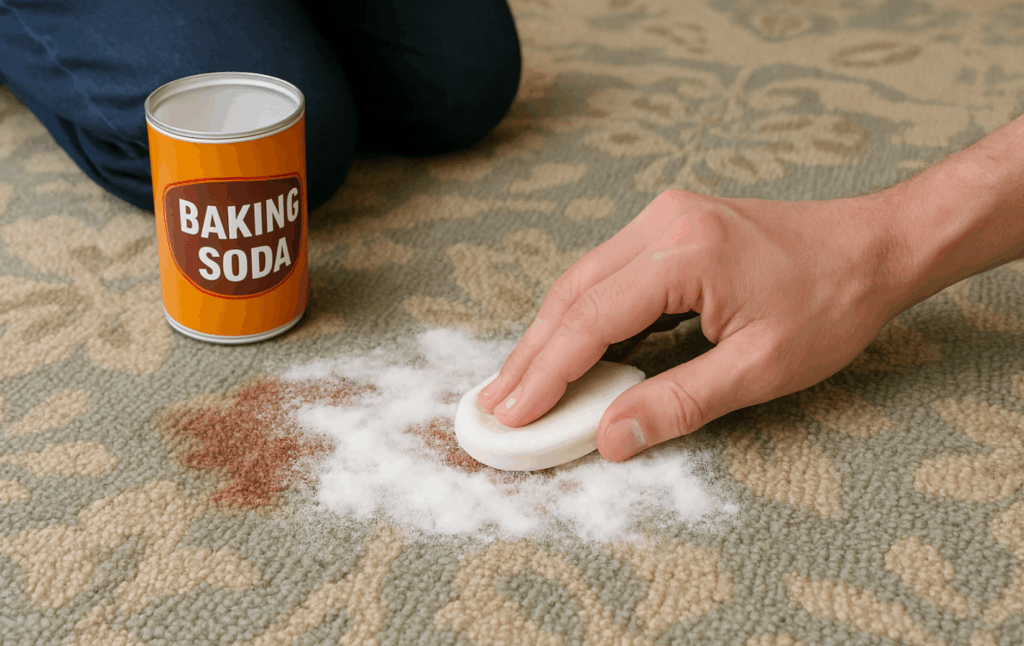
정기적인 청소 관행
진공 청소기: 러그에서 먼지, 먼지, 알레르기 유발 물질을 제거하는 가장 효과적인 방법은 정기적인 진공청소기 청소입니다. 식당과 같이 사람들의 왕래가 잦은 공간의 경우 적어도 일주일에 한 번 청소기로 청소하세요. 러그 섬유가 손상되지 않도록 높이 조절이 가능한 진공청소기를 사용하세요.
스팟 청소: 액체를 흘리거나 얼룩이 묻으면 즉시 처리하여 굳지 않도록 하세요. 깨끗하고 마른 천으로 해당 부위를 닦아 과도한 액체를 흡수합니다. 잘 지워지지 않는 얼룩의 경우 중성 세제를 물과 섞어 해당 부위를 부드럽게 닦아냅니다. 항상 눈에 띄지 않는 작은 부위에 세제를 먼저 테스트하여 러그가 손상되지 않았는지 확인하세요.
딥 클리닝: 러그의 재질에 따라 12~18개월마다 딥 클리닝이 필요할 수 있습니다. 합성 러그의 경우 스팀 청소기를 사용하거나 전문 청소 서비스를 이용하는 것이 좋습니다. 양모나 황마와 같은 천연 섬유 러그의 경우, 섬유가 손상되지 않도록 제조업체의 관리 지침이나 전문가에게 문의하세요.
예방 조치
러그 패드를 사용합니다: 다이닝룸 러그 아래에 러그 패드를 깔면 여러 가지 이점이 있습니다. 러그가 미끄러지는 것을 방지하고 마모를 줄이며 공기의 흐름을 원활하게 하여 진공청소기를 더 효과적으로 사용할 수 있습니다. 가장자리가 보이지 않도록 러그 패드가 러그보다 약간 작은지 확인하세요.
러그를 회전합니다: 균일한 마모를 위해 6개월마다 러그를 180도 회전하세요. 이렇게 하면 발자국과 햇빛 노출을 분산시켜 고르지 않은 색 바램과 마모 패턴을 방지할 수 있습니다.
가구로부터 보호하세요: 무거운 가구는 러그에 영구적인 자국을 남길 수 있습니다. 의자나 테이블의 다리 아래에 가구 컵 받침이나 패드를 사용하여 무게를 고르게 분산시키고 손상을 방지하세요.
계절별 관리 팁
습도 제어: 습도가 높으면 특히 천연 섬유 러그에서 곰팡이와 곰팡이가 번식할 수 있습니다. 제습기나 에어컨을 사용하여 식사 공간을 건조한 환경으로 유지하세요.
햇빛 노출: 직사광선에 장시간 노출되면 색이 바래질 수 있습니다. 햇빛이 가장 강한 시간대에는 커튼이나 블라인드를 사용하여 햇빛 노출을 제한하거나 러그를 주기적으로 교체하여 고르게 퇴색되도록 하세요.
계절별 청소: 봄과 가을은 러그를 대청소하기 좋은 시기입니다. 계절의 변화는 습도와 알레르기 유발 물질의 변화를 가져오기 때문에 러그를 새로 교체할 수 있는 좋은 기회입니다.
8. 결론
식탁에 적합한 러그 사이즈를 선택하면 기능성과 스타일을 모두 향상시킬 수 있습니다. 테이블의 크기, 공간 배치, 선호하는 소재를 고려하여 공간을 보완하고 필요에 맞는 러그를 선택할 수 있습니다.
9. 자주 묻는 질문
- 다이닝룸 러그의 치수는 어떻게 측정하나요?
테이블의 길이와 너비를 측정한 다음 의자를 놓을 수 있도록 양쪽에 24~36인치를 추가합니다.
- 직사각형 테이블 아래에 둥근 러그를 사용해도 되나요?
파격적이긴 하지만 둥근 러그는 방의 디자인을 보완하는 독특한 느낌을 더할 수 있습니다.
- 다이닝룸 러그에 가장 적합한 소재는 무엇인가요?
양모는 내구성이 뛰어나고 얼룩에 강해 식사 공간에 이상적입니다.
- 식당 러그는 얼마나 자주 청소해야 하나요?
매주 진공 청소기로 청소하고 12~18개월마다 전문 청소업체에 의뢰하세요.
- 식당 러그 아래에 러그 패드를 사용해도 되나요?
예, 러그 패드는 미끄러짐을 방지하고 바닥을 보호합니다.

